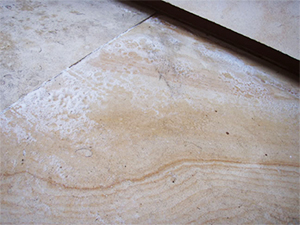Key to Creating Permanent Solutions for Efflorescence and Subflorescence: Find the Source
As a stone restoration contractor you will inevitably encounter the unsightly white powder called efflorescence on freestanding masonry walls. These water-soluble salts can also be found in some patios, showers, basements, and floor installations. When customers have water issues, efflorescence and its cousin subflorescence will tell the story that will help you solve the problem at its source and create permanent solutions.
Water is necessary for all forms of life, but it is not our friend in the construction trades. One of the main goals of any architect is to create a sound building envelope that ensures the elements stay on the outside of the building, but this is often a challenge to achieve. Climate, the grade on which the building is placed, materials used in building, systems such as flashing design on external brick, stone, and concrete, and the internal sources of water from the installed plumbing can all be sources of excess water.
Whether the water is seeping in from inadequate flashing in exterior construction or an improperly installed or failing shower pan that does not allow adequate water drainage, moisture inevitably saturates any absorbent material. Along the way, this moisture picks up salts from mortars and thinset, stone, brick, concrete, and even from ice melting compounds used on the building exterior. These salts can potentially cause damage.
Efflorescence
Efflorescence is the powdery salt that is dissolved in a water source and, through capillary action, migrates from the wet substrate to the drier air, forming salt deposits on the surface.
Subflorescence
Subflorescence is when those same powdery salts are trapped within the stone, mortar, tile, or concrete. Subfloresence can cause damage by crystallizing and pushing against the structure of the hard surface, weakening it, and eventually causing it to flake off in what is called a spall. Combined with the freeze/thaw cycles of the northern states, subflorescence can create incredible damage.
How to Resolve Efflorescence and Subflorescence Problems
The solution for efflorescence and subflorescence is to locate and eliminate the source of the excess water. If an absorbent material sits in a water-soaked area, a condition called rising damp will occur. Moisture is drawn up into the structure much like a dry sponge, causing conditions for ongoing efflorescence. Often for patios, garden walls, and other structures that come into direct contact with the ground, this process can interrupted by the client installing a drainage system, rerouting downspouts, or adding gravel and geotextile fabric at the base of a wall. The object is to move water away from the masonry or tile-cladded structure.
Cleaning and Restoring Efflorescence-Affected Stone
Once the source of moisture is located and corrected, the unsightly powdery substance left behind by efflorescence should be removed from the surface using a dry brush method of cleaning. If this cleans the stone adequately, then you can move on to carefully considering whether a sealer would be beneficial. Research is now under way, but preliminary findings seem to indicate that sealing stone in wet environments may be inadvisable. You may need to wait anywhere from a few weeks to a year before applying sealer, that is, if sealer ought to be applied at all.
Many factors come into play that will determine how long it takes for the stone to dry and whether it ought to be sealed. What is the stone type? Is it set with thinset or mud? Is the location interior or exterior? Is the environment wet or dry? Has the stone previously been sealed? What is the finish of the stone? Does the stone have temperature fluctuations? How is the stone maintained? Is it a commercial or residential application?
Check the stone with a moisture meter to be sure the stone is dry and the efflorescence has run its course before proceeding. If the stone is dry but residue remains, the affected area can be cleaned with limited fresh water, scrubbing with a soft brush, and patting the surface dry with toweling. For larger areas, rinsing and using a squeegee to remove excess water would be advisable. If you are working outside, try to work on a warm day with sun and a good breeze so that you prevent over saturating the stone or masonry. Do not use alkaline cleaners as they are a source of salt and can aggravate the problem.
Moisture-Related Structural Damage
You may need to advise your client that some areas with structural damage might need to be replaced or patched. In the case of mortar used for pointing, it might be necessary to remove failed sections and repoint. Improperly draining shower pans will require that at least part of the floor be removed to make sure drain holes are open. In masonry, flashing may need to be repaired or flexible sealants (caulking) may need to be replaced or even rope weeps installed. For difficult staining and high concentrations of salt, a simple poultice without cleaning agents can be very effective, although they might require more than one application.
Problems with efflorescence and subflorescence can seem daunting, but by sleuthing out the source, measures can be taken to make permanent repairs to any floors or wall surfaces.
